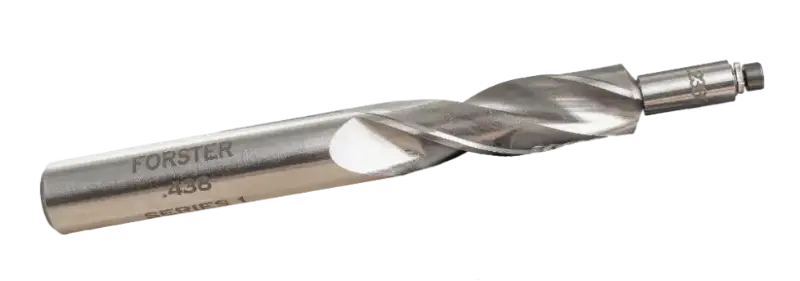Tired of slow, multi-step chambering setups? Our Piloted Rough Drill simplifies the process of boring and pre-drilling, making it faster and more accurate than ever.
Designed with the same piloted bushing system as a chamber reamer, this tool comes in all the common sizes—helping you get as close as possible to your final case dimensions and reducing the workload for your finish reamer.
Why You’ll Love It:
- One Plunge Operation – Ream just short of the body/shoulder junction for fast, efficient roughing.
- Precision Fit – Use the right Reamer Pilot Bushing and stay concentric with the bore.
- Built for Flow – Our screw/washer design allows coolant and chips to flush freely for cleaner cuts. Also much easier to change bushings than an e-clip and more handy than a tool specific screw.

Piloted Roughing Drill
How to Calculate Your Depth of Cut with the Piloted Rough Drill
To get the most accurate rough cut, you’ll need to determine how deep the drill should go without reaching the case’s shoulder/body junction. The key is understanding how much of the case will be unsupported when it’s fully seated in the chamber. That distance helps you set a safe cut depth.
Using a custom Remington 700 action (impact action to be exact) as an example:
- Start with your base-to-shoulder junction measurement
- For a Creedmoor, this is approximately 1.490″.
- Account for the bolt nose counterbore
- The Impact action has a .150″ counterbore—meaning the case base sits .150″ inside the bolt face when chambered.
- Decide how much of the case you want to leave unsupported
- A safe amount is usually .250″.
- Subtract the counterbore and desired unsupported length from the full base-to-shoulder measurement
- 1.490 – 0.250 (the safe amount)
- Final Cut Depth
- In this example, a safe rough drilling depth would be around 1.240″.
Tip: Your cut depth is measured from where the drill starts cutting—NOT from the tip of the pilot.
If you’re confident in your measurements, feel free to get closer—just don’t exceed the shoulder/body junction, and always factor in case stick out.
Have questions before you dive in? Let us know—we’re happy to help you get the most out of your setup.

